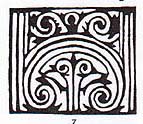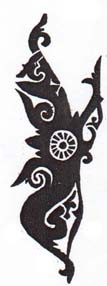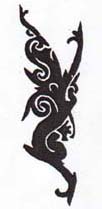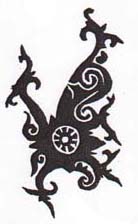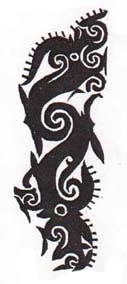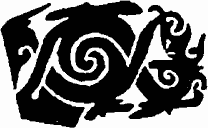Kayan Rejang R.
Kayan is one of the many tribes of Borneo who practice body modification. BME has some examples of their tattoos from the Sarawak Museum. Among the Kayans, women are normally the tattoo artists. [1]
Contents |
Thigh pieces
Sihong is the term for the repeated design of thigh tattoos for Kayan women, and the type of sihongs and where they are placed can tell the class of the woman. Ida telo is the three-ligned pattern tattooed on the back of the thigh of a slave class woman. Middle class woman wore a four-lined pattern ida pat on the back of their thighs as well. Ida tuang or ida lima is for the back of the thigh of a woman of high rank. Uma lekan is also another design worn on the back of the high class. Women of high class can also have an uma pliau tattooed on their front and sides as well.
 Ida Tuang/Ida Lima: Note the hornbill heads at the top of the design. From a tatu block in the Sarawak Museum (No. 166 Brooke Low collection) |
 Ida Pat: From a tatu block in the Sarawak Museum (No. 1434) |
Dogs
Udo Asu are traditional Kayan Borneo tattoos of dog designs (Kayan). These designs are from tatu-blocks in the Sarawak Museum.
Lukut

|

|

|
- The design tattooed on the wrists is termed lukut, i.e. an antique bead much valued by the Kayans, and the significance of the designs is of some interest. When a man is ill, it is supposed that his soul has escaped from his body, and when he recovers it is supposed that his soul has returned to him; to prevent its departure on some future occasion the man will "tie it in" by fastening around his wrist a piece of string on which is threaded a lukut or antique bead, some magic apparently being considered to reside in the bead. However, the string can get broken and the bead lost, wherefore it seems sager to tattoo a representation of the bead on the part of the wrist which it would cover if actually worn. It is of interest to note also that the lukut from having been a charm to prevent the second escape of the soul has come to be regarded as a charm to ward off all disease, and the same applies to its tattooed representation.
Others
- Tuang nganak is a traditional Kayan tattoo design representing a dog with pups.
- The image Kayan (Rejang R.) is an unknown Kayan design, but is obviously related to the tribe's thigh pieces with its sihong structure.
